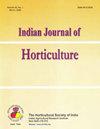基于物候性状的荔枝形态多样性研究
Q4 Agricultural and Biological Sciences
引用次数: 0
摘要
采用29个数量物候性状对30个印度荔枝基因型的形态多样性进行了评价。穗长、穗宽、主次二聚体数、主次二聚体最大长度、主次二聚体最大和最小距离、同一点主次二聚体数(穗上的一次分枝)起源、花丝长度、花药长度和直径、果/丛数和单株产量的变异系数均大于20%。次生二裂数与柱头长度高度相关。果簇数与产量、果重与果蒂厚度也存在相关性。基因型根据穗大小和产量分为两大类。集群1为小穗型,产量较低;集群2为大穗型,产量较高。变异分析表明,穗长、穗宽、次生二歧花序数、初生二歧花序最大长度、雄花长度、雄蕊长度、花梗厚度、果/簇数和果重是鉴定高产基因型的重要性状。本文章由计算机程序翻译,如有差异,请以英文原文为准。
Morphological diversity in litchi based on phenological traits
Twenty nine quantitative phenological traits were used to assess the morphological diversity among30 Indianlitchi genotypes. Coefficients of variation for length and width of panicle, number of primary and secondarydichasia, maximum length of primary and secondary dichasia, maximum and minimum distance between twoprimary dichasia and origin of number of primary dichasia (primary branches on panicle) from same point,filament length, length and diameter of anther, number of fruits/cluster and yield/ plant were more than 20%.The number of secondary dichasia was highly correlated with the length of stigma. Similarly, number of fruitsper cluster and yield, and fruit weight and thickness of pedicle were also correlated. Genotypes were dividedinto two main groups which corresponding to the size of the panicle and yield. Cluster-I contained genotypesof comparatively small panicle with lower yield, while cluster-II is composed of larger panicle with higheryield. From variability analysis, length and width of panicle, number of secondary dichasia, maximum lengthof primary dichasia, length of male flower, stamen length, thickness of pedicle, number of fruits/cluster andfruit weight were identified as important traits for identifying high-yielding genotypes.
求助全文
通过发布文献求助,成功后即可免费获取论文全文。
去求助
来源期刊

Indian Journal of Horticulture
农林科学-园艺
CiteScore
0.50
自引率
0.00%
发文量
22
审稿时长
4-8 weeks
期刊介绍:
Information not localized
 求助内容:
求助内容: 应助结果提醒方式:
应助结果提醒方式:


